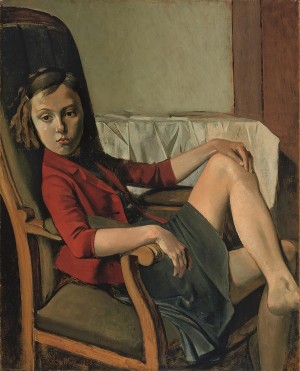Balthus — Painter and Provocateur
If you go to see the latest Balthus (Balthasar Klossowski, 1908-2001) exhibit at the Metropolitan Museum of Art in New York City, expecting perhaps to unravel the true identity of this elusive and enigmatic artist, you will likely leave empty-handed. But if instead, you enter his paintings as a voyeuristic yet intensely secretive adolescent might — preferably a young girl — you will be richly rewarded. And if you happen to enjoy the company of cats, it is all the better.
Thirty years have passed since the last exhibit of his works, and according to curator Sabine Rewald, many visitors will be too young to remember “the powerful and troubling effect” Balthus had over his audience. He was a master at portraying nubile girls, provocative yet sometimes ungainly, rebellious, bored, and seemingly unconscious of the effect they were creating on their elders. Balthus, on the other hand, never averted depicting the incipient eroticism at play in these portraits.
The current exhibition at the Met, entitled Balthus: Cats and Girls—Paintings and Provocations, focuses on the early decades of the artist’s career, from the mid-1930s to the 1950s. It is a compact show considering the artist had another four decades of work not on view here, and its strength lies largely in the 10 remarkable portraits he did of the young model Therese Blanchard between 1936 and 1939. Thirty-four paintings comprise the exhibit, many arresting in their content but few displaying the depth and perfection of execution evident in the Therese canvases. Another 40 ink drawings featuring his cat, Mitsou, are on display, produced by the artist in 1919 at the tender age of 11. Believed for many years to be lost and never before publicly displayed, these renderings are a particularly poignant feature of this show. The poet Rainer Maria Rilke, a family friend and later lover of the boy’s mother, so loved the drawings, he arranged for their publication and at his insistence, had the young artist sign the book as “Baltusz,” the shortened version of Balthasar (later changed to Balthus).
Such artistic precociousness, though rare, can be to some degree attributed to Balthus’ own upbringing. Both Balthus and his older brother Pierre were born in Paris into a cultural milieu ideal for his creative pursuits. His father Erich Klossowski was a painter and art historian while his mother, known as Baladine, was also an accomplished painter in her own right. The family’s ancestry has been debated in several biographies. His father’s family, escaping from Poland in 1830 during a failed revolt against Russia, obtained German citizenship in East Prussia. Some controversy remains about the possibility of any ethnic Jewish heritage on his mother’s side, which according to Nicholas Fox Weber, a biographer of the painter, was flatly denied by the artist. (During the introductory remarks by the curator, another journalist bluntly raised the issue of his ancestry as a Polish Jew, but Ms. Rewald, who interviewed Balthus, politely said she had “the letters” and the family was indeed German. I will leave it to the reader if she or he chooses to investigate the point further but it is the works themselves and their lasting significance that obviously are of concern to the curator and this reviewer as well.)
The artist’s influences were numerous: Masaccio, Piero della Francesca, Simone Martini, Nicolas Poussin, Ingres, Goya, Courbet, Degas, and Cézanne, to name a few. Even in an exhibit as contained as this one is, the viewer can enjoy finding a gesture, a pattern, a choice of color that evokes memories of a long line of painters. As for his own contemporary fans, they too were plentiful — writers like Albert Camus and Jean Cocteau, painters such as Pablo Picasso and sculptor Alberto Giacometti, and gallery owner and dealer Pierre Matisse (who supported the artist and his family financially in his later years). His first exhibition in Paris, The Guitar Lesson (1934) brought him considerable notoriety. It is an understandable reaction even today, when one considers the sexually explicit depiction of a girl arched over the lap of a female teacher, whose hands are placed on the girl’s body as if she is playing a guitar.
However challenging Balthus’ subject matter can be to some viewers’ sensibilities, he was really a classicist and an adherent of the Romantic school. As he described himself to Ms. Rewald in his later years, he was a “timeless realist.” Events of a political or cultural nature are generally absent in this suspension of time’s passing. Ultimately, it is this juxtaposition of his strange depictions of scene and subject with the stillness of his particular universe that gives the work a jolting power.
The Paintings
Therese Blanchard was a neighbor’s child but obviously no ordinary prepubescent girl to the artist when he first encountered her. Behind the boredom and occasional sullenness — she is never seen smiling — we sense an intelligence and deep sadness at work in these portraits. When Ms. Rewald interviewed some of the Balthus models in their matronly years, she unhappily discovered that Therese had died at 25 of unknown causes. This fact added a tint of pathos to my own viewing, as if the child had a presentiment of her own demise.
(Article continued on next page)

